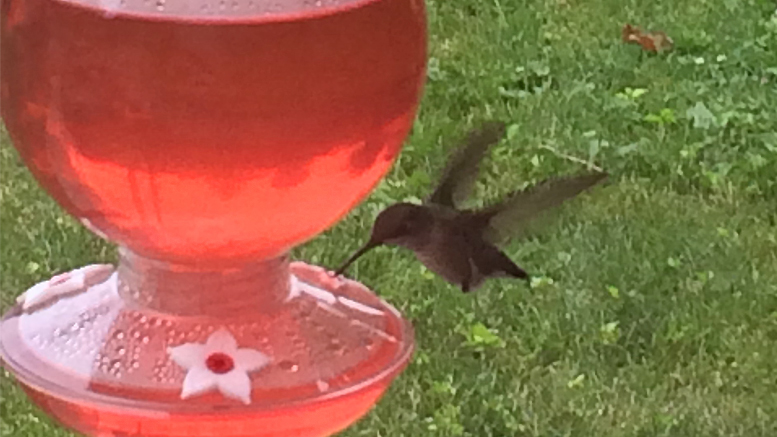By: John Carlson—
With only one hummingbird regularly flocking to our feeder these days, I nevertheless relish evenings spent on our back deck, watching it cavort.
It’s an activity that follows a familiar pattern.
Pour some bourbon into a glass. Carry the glass out to the deck overlooking our hummingbird feeder. Pull down my goggles. Sip the whiskey and watch nature’s show, all while giving thanks for this place where a hummingbird lives in perfect harmony with wild turkeys.
I mean, Wild Turkey. You know, the bourbon.
But wait, you might say. Why goggles?
My response to that is this: Have you ever taken a close look at a hummingbird’s beak? It’s like a flying hypodermic needle. Hummingbirds require this needle-like proboscis to poke through the dinky holes in hummingbird feeders and suck out the sugar water on which they thrive. This is why there are no hummingbirds buzzing around with blunt, oversized beaks like a toucan’s, and no hummingbird sub-species named in honor of dudes with huge honkers, such as Cyrano de Bergerac.
Anyway, I’m no worrywart. But when that hummingbird out back gets all stoked up on sugar water, a recurrent fear comes to mind.
What if it spears me through an eyeball?
Having raised two children with my wife, Nancy, I remember how things used to be the day after Halloween. Fueled by overdoses of candy, the kids would have been swinging from our fancy chandelier, had we owned one. They’d scamper up trees, where we’d track them following the trail of mini-Milky Way and Snickers wrappers. In just ten minutes of cartoon watching, the gaps between the couch cushions would be crammed to overflowing with little Milk Duds boxes.
And this was with our kids, people weighing approximately 30- to 60-pounds each.
A hummingbird weighs, what? Half-an-ounce? Yet it’s out there slurping sugar water all day, every day. Not surprisingly then, after bellying up to the bar for a dozen or so shots, our hummingbird seems to disengage from the feeder with a certain callous joie d’vivre.
It’s then that I notice the low passes it makes over me before barrel rolling into a return pass for more of that joy juice. Yes, I may be overstating things just a teeny-weeny bit. But it’s like it’s playing chicken, only with my face. You lose if you flinch.
I always flinch.
Having wondered the other day if my hummingbird was intentionally messing with me, I got on the Internet to assure myself it wasn’t, but there it was, plain as day. “When Hummingbirds Attack,” the post read. It showed people peacefully going about their daily business when, all of a sudden, hummingbirds turned into greasy little sky punks.
In one video, a screaming, stumbling man vainly tried swatting them away, while two tenacious hummingbirds poked from his bleeding eyeballs like a couple knitting needles attached to tiny whirring wings.
OK, actually, I just made all that up. It never happened. I didn’t see anything even remotely that disturbing. But the videos did show some not-very-happy guys swatting the air as hummingbirds buzzed their heads, making nuisances of themselves while turning these big construction-type hulks into feinting, dodging wussie-boys.
I was embarrassed for them.
This, then, led me to look up U.S. Deaths Attributed to Hummingbird Attacks, which revealed some startling statistics. In 2017, for example, there were … well, none. In fact, I couldn’t find evidence of any hummingbird-related deaths in all of avian history.
Ditto for hummingbird-related eyeball assaults.
So down the toilet went the entire premise of this column. Guess hummingbirds don’t hurt human beings after all. Not out of spite, anyway.
But what I did find was a hummingbird facing its own sorry demise. Not at the hands of a person, though.
At the freaky hands of a praying mantis.
This skinny, lanky, prayerful insect set up an ambush right on a feeder. When the hummingbird hooked up for a quick sip of sugar water, the mantis grabbed it by the beak. You could actually hear the hummingbird crying as he vainly fluttered to get away, but the mantis was having none of that. While I generally think in such situations that nature knows best, I was grateful to see a human hand come into view. Flicking the mantis off the feeder, somebody’s heroic middle finger allowed the chastened hummingbird to fly away, and feed another day.
This made me happy.
Yes, my hummingbird’s aerial antics may freak me out just a little bit, and occasionally make me jerk for cover like I’m spastic.
But a praying mantis killing one of them? That thought bums me out a whole lot worse.
A former longtime feature writer and columnist for The Star Press in Muncie, Indiana, John Carlson is a storyteller with an unflagging appreciation for the wonderful people of East Central Indiana and the tales of their lives, be they funny, poignant, inspirational or all three. John’s columns appear on Muncie Journal every Friday.



